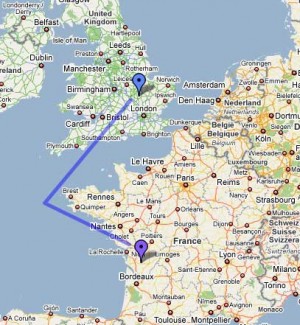Seems that I was no sooner asleep when the lights came on this morning. My aching back ... Seven hours yesterday of combat, five on oxygen, and now up and at ‘em again.
Even though Herman had flown the day before … Seems that I was no sooner asleep when the lights came on this morning. My aching back … Seven hours yesterday of combat, five on oxygen, and now up and at ‘em again.
The heavy bombers went into occupied France, and the target for Herman’s crew was the airfield at Cognac. They flew near several severe flak barrages. The enemy heavily fortified their airfields and U-boat installations … La Rochelle, Brest, others on the coast.
I guess Bomber Command decided to finish up 1943 in style. At briefing we learned this was to be one of the largest fleet of planes to be sent across in one mission. We were given the target, the routing, the fighter support, the weather, and the complete dope prior to take off. It was to be another long haul, just what length I really did not appreciate until night.
The bombing run … this is the first time I had been on a visual target. There we were 23 ships in bomb formation, spread out for the best concentration. It was a tough go to sit up there and ride through that damn flak. It burst all around. The red flash, the black smoke … “pop”, “boom”, “pop” – can now really understand the expression “flak happy.”
From what I’ve read, I think “flak happy” referred to an airman who may not have shown it but was terrified of the flak. In other words, they weren’t happy at all.
The weather was so bad flying home that they couldn’t see the wing tips of their own plane. Low on gas, they were looking for anywhere to land when suddenly Steve picked up a track of lights that meant a nearby airfield. Smithy landed at Chelveston, an airfield of the 305th Bomb Group, 14 miles from Thurleigh.
Happy New Year, Daddy.



Rowdy
Posted at 18:30h, 22 MayI think you are defining “flak happy” correctly. Although it was not too common that a young man couldn’t handle the fear, there were enough instances of it that it touched my father’s crews twice.
One man flew two combat missions with the crew he had joined several months earlier in the states. He was removed, with the only comment Dad ever made about it being, “he didn’t work out.” However, the man finished his tour with another crew, so something else happened to him in relation to Dad’s crew. I never knew the reason, and oddly enough, I’ve never found anything more about him on the net.
A second man on Dad’s second crew was described as going berserk at his gun on an early mission and was removed from the crew. Again, I’ve found nothing more about him.
A third man, who apparently completed his tour, supposedly went berserk at the base one night and was taken away by the white coats. Dad liked the man but never told that story and my knowledge of it comes from a former gunner on the crew.
A fourth man, a member of another crew, was the only survivor of two aircraft that collided over the base during assembly one day. He parachuted to safety and was so shaken that he never flew again. They shipped him home and he served out his term of service in the states. To this day, he has never had anything to do with any of the reunions.
There is no telling how many stories like these actually took place, since these four touched just one crew…my father’s. There were perhaps 400-500 crews that flew from the base during the months the Group was mobilized. I think it’s reasonable to assume that most of the surviving aviators had a number of memories such as these that came home with them.
Just as I noted in the “Flags of Our Fathers” section, these guys simply wanted to put these things behind them. I have another conversation going on with a daughter of one of my father’s pilots…similar to your experience, although her father went on to a long Air Force career, he never spoke much about WWII.